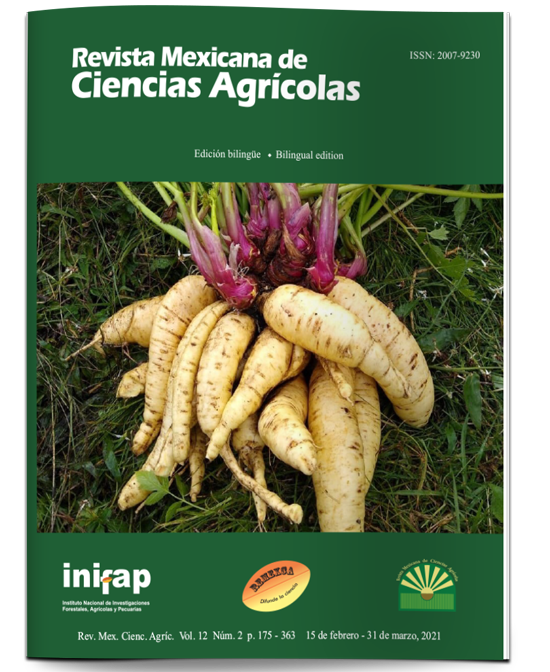Planting density in verdolaga growth
DOI:
https://doi.org/10.29312/remexca.v12i2.2848Keywords:
phenological stages, quelites, verdolagaAbstract
In Mexico there are more than 358 species of plants, of which only tender leaves and stems are consumed, known as ‘quelites’. Given the productive, economic and nutritional potential of these species, including verdolaga, factors that affect their growth and development need to be determined. Verdolaga is an alternative as a vegetable due to its nutritional, productive and economic potential; its yield will be determined mainly by the development of stems and leaves, so the knowledge generated about the factors that affect its growth is of great agronomic importance. This research assessed the effect of three planting densities on verdolaga growth. Data for three phenological stages of verdolaga development (vegetative development, vegetative maturity and flowering) were considered to determine whether there were significant differences between the mean treatments evaluated by an Anova and to determine whether variance homogeneity existed, the Levene method was carried out. Plants planted at a high planting density (295 plants m-1 linear) had higher height, smaller stem diameter, fewer leaves (large and small) and lower branch development (branch length) compared to those planted at medium and low planting densities (250 and 134 plants m-1 linear); however, the number of leaves on the branches depends on the level of the canopy where they are located. Planting density is a contributing factor in determining the growth of the ‘Chapingo’ verdolaga.
Downloads
Downloads
Published
How to Cite
Issue
Section
License
The authors who publish in Revista Mexicana de Ciencias Agrícolas accept the following conditions:
In accordance with copyright laws, Revista Mexicana de Ciencias Agrícolas recognizes and respects the authors’ moral right and ownership of property rights which will be transferred to the journal for dissemination in open access. Invariably, all the authors have to sign a letter of transfer of property rights and of originality of the article to Instituto Nacional de Investigaciones Forestales, Agrícolas y Pecuarias (INIFAP) [National Institute of Forestry, Agricultural and Livestock Research]. The author(s) must pay a fee for the reception of articles before proceeding to editorial review.
All the texts published by Revista Mexicana de Ciencias Agrícolas —with no exception— are distributed under a Creative Commons License Attribution-NonCommercial 4.0 International (CC BY-NC 4.0), which allows third parties to use the publication as long as the work’s authorship and its first publication in this journal are mentioned.
The author(s) can enter into independent and additional contractual agreements for the nonexclusive distribution of the version of the article published in Revista Mexicana de Ciencias Agrícolas (for example include it into an institutional repository or publish it in a book) as long as it is clearly and explicitly indicated that the work was published for the first time in Revista Mexicana de Ciencias Agrícolas.
For all the above, the authors shall send the Letter-transfer of Property Rights for the first publication duly filled in and signed by the author(s). This form must be sent as a PDF file to: revista_atm@yahoo.com.mx; cienciasagricola@inifap.gob.mx; remexca2017@gmail.
This work is licensed under a Creative Commons Attribution-Noncommercial 4.0 International license.



